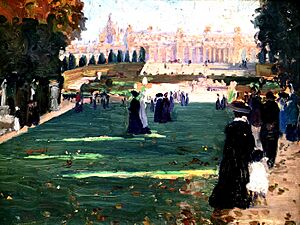Ethel Carrick facts for kids
Quick facts for kids
Ethel Carrick
|
|
|---|---|

Ethel Carrick, c.1912
|
|
| Born | 7 February 1872 Uxbridge, Middlesex, England
|
| Died | 17 June 1952 (aged 80) Melbourne, Australia
|
| Education |
|
| Movement | Impressionism, Post-Impressionism |
| Spouse(s) | Emanuel Phillips Fox |
Ethel Carrick, also known as Ethel Carrick Fox, was a talented English painter. She was born on February 7, 1872, and lived until June 17, 1952. Ethel is famous for her beautiful paintings in the Impressionist and Post-Impressionist styles. She spent a lot of her life painting in France and Australia. In Australia, she was connected to a group of artists called the Heidelberg School.
About Ethel's Life
Ethel Carrick was born in Uxbridge, England. Her family was quite wealthy, and she was one of ten children! She studied art in London at the Guildhall School of Music and the Slade School of Fine Art.
In 1905, Ethel married Emanuel Phillips Fox, who was also a well-known Australian Impressionist painter. They moved to Paris, France, and lived there until 1913. During this time, Ethel traveled a lot. She visited many places in Europe, North Africa, and even the South Pacific, like Tahiti. She also made trips to Australia in 1908 and 1913.
When World War I started, Ethel and Emanuel moved to Melbourne, Australia. They helped organize events to raise money for the war and to support the French Red Cross.
Sadly, Emanuel passed away in 1915. After his death, Ethel continued to travel for about twenty years. She explored the Middle East, parts of Asia like India, and Europe. She would often return to Australia to show her artwork and go on painting trips around the country. In the 1920s, she even taught painting in Paris, especially still life art. Many of her students were from Australia and America.
Ethel Carrick passed away in Melbourne in 1952 when she was 80 years old.
Her Art and Style


Ethel Carrick was mainly a painter. She was known for her paintings of flowers, landscapes, and busy outdoor scenes in cities and on beaches. Many of these scenes were inspired by her travels, like her paintings of outdoor markets in the Middle East. Later, in the 1920s, she started painting more flower studies. During World War II, when she was in Australia, she painted scenes of women working to help the war effort.
Ethel started her career as an Impressionist painter, often painting outdoors (this is called plein air painting). But she quickly moved towards a style called Post-Impressionism. This style used bolder shapes and stronger color differences. Some of her paintings from around 1911-1912 even show a style called Fauvism. Fauvist art uses very bright colors, is quite abstract, and has a loose, free way of applying paint.
Ethel first showed her art in London in 1903. She regularly exhibited her work at important art shows in Paris, like the Salon d'Automne, starting in 1906. She also showed her art at the London Royal Academy of Arts and in galleries in Melbourne and Sydney, Australia. She even had joint exhibitions with her husband.
In 1911, she became a sociétaire (a member) of the Salon d'Automne. From 1912 to about 1925, she was a jury member for the Salon. These were very important roles for a woman at that time, showing how much the art world in Paris respected her. Before World War I, she was also the vice-president of the International Union of Women Artists.
For a long time, Ethel's art was not as famous as her husband's. This was partly because she spent a lot of time helping his career. She encouraged people to buy his art and organized his exhibitions. However, in recent years, more and more people are recognizing her talent. Many art experts now think her work was even more daring and exciting than her husband's.
Her paintings have become very valuable. In 1996, one of her paintings sold for A$105,500, which was a record for an Australian woman artist at the time. Another painting, Market Under Trees, sold for over A$1 million in 2008! This shows how much her art is now appreciated.
In 2011, the Queensland Art Gallery held a special exhibition that showed the work of both Ethel Carrick and her husband together.
Exhibitions
Ethel Carrick was a very active artist and showed her work in many exhibitions during her lifetime. She had several solo shows where only her art was displayed, starting in 1908 in Melbourne. She also participated in many group exhibitions with other artists in major cities like London, Paris, Melbourne, and Sydney. Her art was featured in important events such as the Salon d'Automne in Paris and the Royal Academy of Arts in London. She even won an award, a diplome d'honneur, at an international exhibition in Bordeaux in 1928 for her painting Manly Beach - summer is here.
See also
 In Spanish: Ethel Carrick para niños
In Spanish: Ethel Carrick para niños

